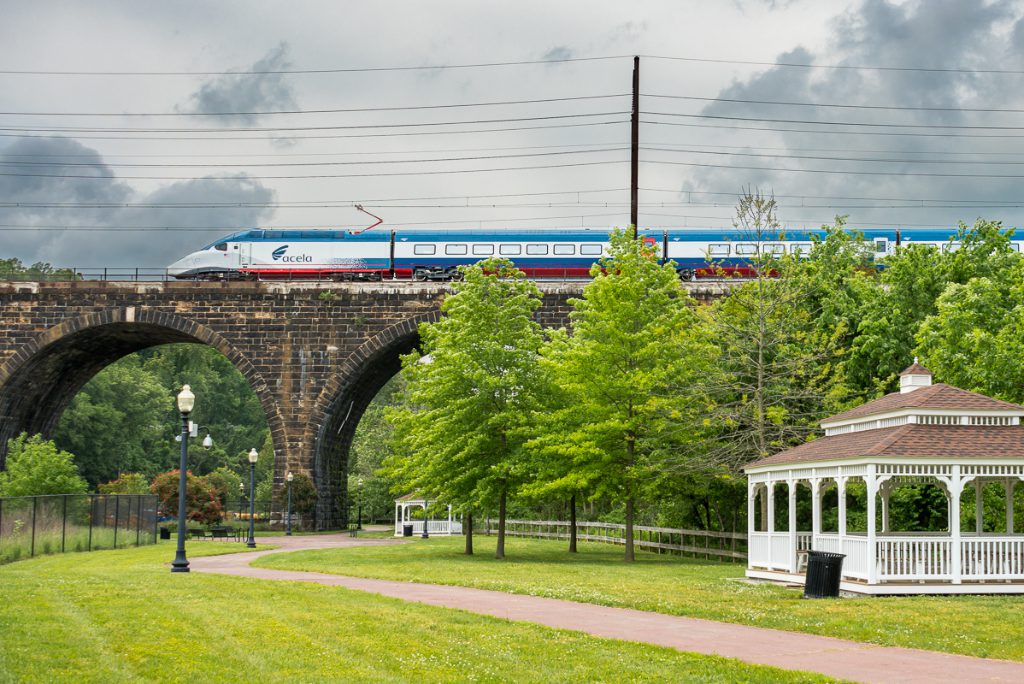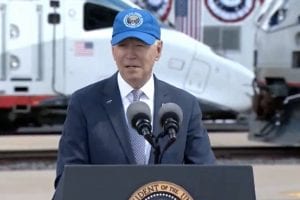Skift Take
U.S. lawmakers have been alarmingly indifferent about infrastructure for years. The pandemic appears to have provided the political will to change that, but the climate crisis is also a factor. The president used Amtrak Friday to make his case.
U.S. President Joe Biden traveled to Philadelphia on Friday to celebrate Amtrak on the eve of the U.S. passenger railroad’s 50th anniversary on May 1.
While he was a U.S. senator for Delaware, Biden commuted daily more than 1 million miles on Amtrak between D.C. and his home in Wilmington. On Friday, though, the president flew to Philadelphia because of security concerns.
The president reaffirmed his faith in rail travel’s overall benefit as a way to reduce the U.S. transportation sector’s greenhouse gas emissions, playing up what he called the lower climate impact of trains and projected economic benefit.
“When I think about fighting climate change, I think of expanding rail, which will also bring jobs,” said President Biden, speaking at William H. Gray III 30th Street Station in Philadelphia. “Rail travel has an incredibly positive impact on the environment. We have a huge opportunity to provide fast, safe, reliable, clean transportation.”
Biden spoke in front of one of Amtrak’s planned new railcars to replace the current cars on its express service, Acela. The new Acela railcars weigh less than today’s Acela railcars, or ‘trainsets’ in the industry jargon. The lighter weight and greater carrying capacity of 20 percent more passengers should translate into lower energy consumption per passenger.
The Biden Administration’s federal budget proposed earlier this month allotted $2.7 billion in subsidies for Amtrak, a jump of about $700 million over pre-pandemic annual averages. Yet Amtrak on Thursday asked Congress for $3.88 billion next fiscal year for “base needs.” The pandemic devastated Amtrak’s revenue in 2020, derailing a path to breaking even after accounting for subsidies.
Amtrak officials hope to also benefit from the Biden Administration’s push for $2.3 trillion in U.S. stimulus spending. It asked Congress on Thursday for $31 billion in total over five years to modernize the route between Boston to Washington, D.C., its most-used route.
The Biden bill announced in early April planned to set aside $80 billion for U.S. rail infrastructure nationwide. A large chunk of that would benefit Amtrak.
“The Biden plan would devote about 25 percent of transportation funds to Amtrak,” said Randal O’Toole, a senior fellow at the libertarian Cato Institute. “Yet Amtrak carries one-tenth of one percent of all passenger travel [meaning planes, buses, and rail]. The Biden plan is budgeting the most money for routes that aren’t going to increase ridership all that much.”
About $13 billion of the Biden plan would go to building a new tunnel under the Hudson River that connects New Jersey and New York City’s Penn Station. The project would aim to avoid a structural failure of the aging Holland Tunnel. A long-term loss of current tunnel access would slash the service Amtrak could send across the river by 75 percent at peak times. Long-term closure of this transit chokepoint could devastate New York and Eastern seaboard service routed through the city.
A project to replace a 143-year-old tunnel in Baltimore is also urgent, Amtrak said.
Biden namechecked both projects as priorities on Friday. But he also championed the idea of expanding Amtrak’s service nationwide to 160 underserved or un-served communities.
“Think of the opportunity of connecting Milwaukee to Green Bay to Madison,” Biden said. “Or Scranton and Allentown to New York. Or Indianapolis to Louisville.”
Biden also talked up high-speed rail’s potential, though high-speed rail doesn’t really figure in the current round of proposed spending.
“Imagine a two-hour train ride between Atlanta and Charlotte, going at speeds of up to 220 miles-an-hour,” Biden said. “Imagine a two-and-a-half-hour trip between Chicago and Detroit. Or a faster trip between Los Angeles and Las Vegas.
Amtrak Pitches Its Climate Friendliness
Amtrak began this week adding carbon emission savings estimates on its train tickets for select routes. This may play to a theme outlined by Transportation Secretary Pete Buttigieg in a commitment to greener transit options.
Amtrak’s carbon estimates for train rides in the northeastern U.S. corridor generate 83 percent fewer carbon emissions than driving and up to 73 percent less than flying, Amtrak CEO Bill Flynn said on Friday. The rail operator applied emission estimates from the U.S. Environmental Protection Agency.
But the emissions estimate appeared to assume full trains. Even though before the pandemic, Amtrak ran trains less than half full, on average. Many Amtrak trains use diesel fuel, and the railway’s electric-powered trains mostly use electricity generated by burning fossil fuels.
Some airline executives point to gains that the air sector has been making relative to rail. The Department of Transportation publishes the Transporation Data Energy Book, and the data shows that planes have been improving their energy intensity, or the amount of energy they need to move passengers, faster than Amtrak on a per-mile basis. In 2018, planes needed 2.3 units of energy per passenger mile, compared with Amtrak’s 1.5, the most recent report said.
Amtrak’s Expansion Plan
Amtrak CEO Bill Flynn on Friday nodded to the railway’s ambition to dramatically expand its passenger network by 2035 by analyzing city pairs that could generate the most additional ridership cost-effectively.
The U.S. passenger rail network is far less developed than in many Western European countries, Japan, and China.
Biden particularly expressed concern on Friday about China having a much faster and more extensive rail network than the U.S.
One cause for the U.S. system has been a comparative lack of state funding. Before the pandemic, U.S. infrastructure projects for airports typically claimed 90 cents of federal government money for every 10 cents raised from states and municipalities. But federal rules haven’t historically given the same benefit to passenger rail service.
Another reason is that rail projects in that the U.S. often has unusually high, and often unexplainedly high, construction costs. The proposed new tunnel between New York and New Jersey would cost around $3 billion a mile. London’s recently built tunnel, Crossrail, costs less than half that on a per-mile basis. For context, see a report from Tunnel Business magazine.
Rail Funding Talks Loom
Republicans have countered the Democratic proposal with a far smaller infrastructure bill that would include only a modest rise in Amtrak funding and a $20 billion total for rail generally. Experts expect voting in July.
Amtrak’s expansion plans build on years of advocacy.
“The demand is clearly there for additional short-corridor service throughout the U.S., which includes both additional frequencies for existing routes and establishing new routes between city pairs,” said Amtrak’s then-CEO Richard Anderson in 2019 Congressional testimony. (Anderson spoke in September 2019 at the Skift Global Forum in New York City.) Anderson stepped down last year, with Bill Flynn, another airline executive, stepping into the CEO role.
Passenger rail service Amtrak will have to fight with lobbyists from airports, airlines, cruise ports, and other players for a share of the once-in-a-generation funding bonanza. Many lobbying groups are eager for more federal subsidies, including even the hotel lobby (though not specifically from infrastructure spending).
Yet Biden has for decades had a special place in his heart for Amtrak, and he displayed that fondness on Friday, after an Amtrak conductor, Blake Weaver, who worked Biden’s old route, introduced the president.
“These fellows work like the Devil,” Biden said, noting in a tribute that he used to hold annual parties with the Amtrak employees who he often would see on the route.
“The best days for Amtrak, rail, and America are ahead,” Biden said.
The Daily Newsletter
Our daily coverage of the global travel industry. Written by editors and analysts from across Skift’s brands.
Have a confidential tip for Skift? Get in touch
Tags: amtrak, Biden, Biden Administration, infrastructure, rail, rail travel, trains
Photo credit: A test run of a pre-production Acela trainset on a line crossing High Bridge, a 1904 stone arch bridge at Coatesville, Pennsylvania. Amtrak

